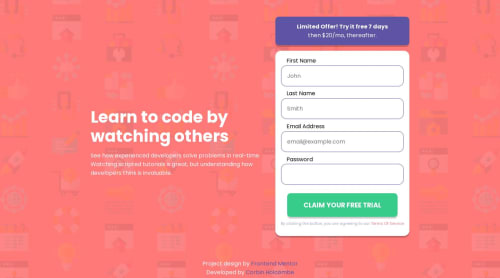Intro Page with Sign-Up Form, Created with Vanilla HTMl, CSS, and JS!

Solution retrospective
I’m really happy with how I managed to turn the given design into a working, responsive page with basic form validation. Especially since mobile-first development still feels difficult. Next time, I might plan out my CSS structure a bit more before diving in, and possibly try out a CSS preprocessor to keep things cleaner and more manageable.
What challenges did you encounter, and how did you overcome them?The hardest part was definitely dealing with the giant background image that messed up my layout. After some trial and error, I wrapped it in a container div and tweaked its positioning until it fit nicely without causing weird overflow issues. Just experimenting and checking online tips helped me figure it out. Most of the project seemed surprisingly simple.
What specific areas of your project would you like help with?I’d love some pointers on making the page even more accessible, especially getting the color contrast right. Also, any advice on making my JavaScript validation more streamlined and flexible would be super helpful for taking this to the next level. I also would appreciate any tips to help make responsive layouts more approachable!
As always, if anyone has any questions, I include much more comprehensive information about the project on my GitHub repo!
Please log in to post a comment
Log in with GitHubCommunity feedback
No feedback yet. Be the first to give feedback on Corbinhol's solution.
Join our Discord community
Join thousands of Frontend Mentor community members taking the challenges, sharing resources, helping each other, and chatting about all things front-end!
Join our Discord